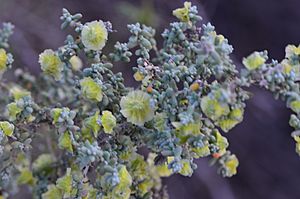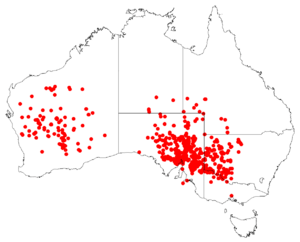Maireana pyramidata facts for kids
Quick facts for kids Maireana pyramidata |
|
|---|---|
 |
|
| Maireana pyramidata (fruit) | |
| Conservation status | |
|
NT (TPWCA)
|
|
| Scientific classification | |
| Genus: |
Maireana
|
| Species: |
pyramidata
|
 |
|
| Occurrence data for M. pyramidata from the AVH | |
| Synonyms | |
|
Kochia pyramidata Benth. |
|
The Maireana pyramidata is a special kind of plant found only in Australia. People often call it the sago bush, black bluebush, or shrubby bluebush. It belongs to a group of plants called Maireana and is part of the Amaranthaceae family. You can find this plant growing across many parts of inland Australia, including Victoria, New South Wales, Queensland, the Northern Territory, and Western Australia.
What Does It Look Like?
The Maireana pyramidata is a small, bushy shrub. It usually grows between 0.3 and 1.5 meters tall, which is about knee-high to a bit taller than an adult. Its branches are stiff and covered with soft, woolly hairs.
Its leaves are thin and shaped like cylinders. They grow one after another along the stem. These leaves are also covered with tiny hairs, some of which look like tiny trees! This plant produces its fruits from August to November each year.
Reproduction
Some Maireana pyramidata plants have only male flowers, while others have only female flowers. This means that for new seeds to form, pollen from a male plant needs to reach a female plant.
Where Does It Grow?
This plant is common in the drier parts of Australia. It likes to grow in certain types of soil. You'll often find it in places with chalky soils, salty flat areas, or near salt lakes. It can even grow in areas that sometimes get flooded.
In Victoria, you can spot it in the far northwest. This includes areas around Mildura, Red Cliffs, Lake Culluleraine, and the region between Kerang and Swan Hill.
In New South Wales, it grows in several inland areas. It is also widespread across many regions of Western Australia, including deserts and rangelands.
Plant Name and History
The Maireana pyramidata was first described by a scientist named George Bentham in 1870. He originally named it Kochia pyramidata. The first plant samples used to describe it were collected near the Lachlan River by Alan Cunningham.
Later, in 1975, another scientist named Wilson decided that this plant fit better into the Maireana group. So, he officially changed its name to Maireana pyramidata.
The second part of its name, pyramidata, comes from the shape of its fruit. The center of the fruit looks like a small pyramid!

